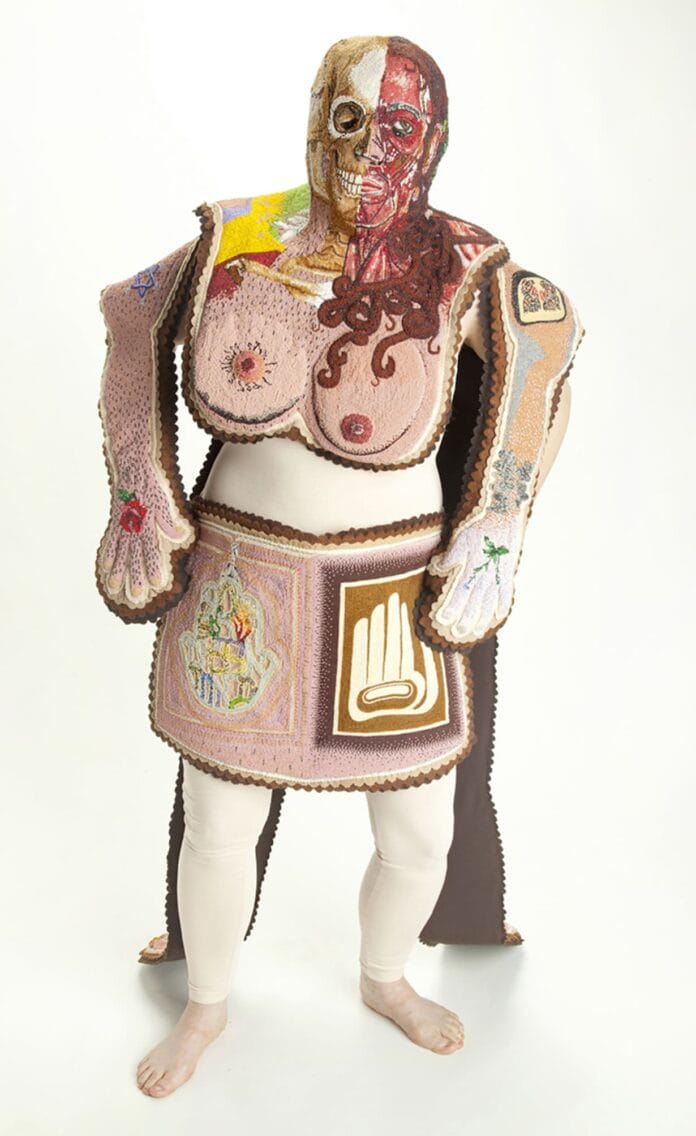Corey Stein’s life has always been shaped by contrasts. Born to a Jewish father from New York and a Tlingit mother from Alaska, she grew up at the intersection of two rich but vastly different cultural traditions. These dual influences became the foundation of her creative identity, giving her an awareness of difference and the humor that can arise when worlds collide.
Art has always been central to her life. Determined to pursue her passion, Stein earned a Master of Fine Arts degree at California Institute of the Arts (CalArts), where she refined her ability to experiment and translate her experiences into a unique artistic language. Today, her work reflects the complexity of her background, drawing on heritage, humor, and tradition to explore contemporary issues.
Artistic Vision
Stein’s art has often been described as environmental observations and connections. Rather than presenting straightforward narratives, she thrives on surprise, wordplay, and juxtapositions that ask the viewer to see familiar things in unexpected ways.
This playful yet thoughtful approach gives her work a distinct voice. Humor serves as an entry point, but beneath the surface lies a serious exploration of identity, community, and culture. By reinterpreting traditional Native American art forms such as beadwork, Stein creates new visual languages that speak directly to today’s social and cultural concerns.
Heritage and Humor
The blending of cultural legacies is a recurring theme in Stein’s practice. From her father’s Jewish traditions to her mother’s Tlingit heritage, her work highlights the richness that emerges from diversity. She doesn’t smooth over contradictions; instead, she amplifies them, finding humor and meaning in their interplay.
These juxtapositions allow Stein to raise questions about identity and belonging while also entertaining her audiences. Laughter, for her, is not an end in itself but a bridge to deeper reflection.
Community and Responsibility
For Stein, art extends beyond self-expression. She sees her work as part of a larger responsibility to build dialogue, foster inclusivity, and educate audiences. As definitions of community evolve, she engages with ideas of accessibility, particularly the erasure of boundaries between disability and ability.
She also acknowledges the urgent need for art in society, especially as programs in schools continue to disappear. Her practice stands as a reminder of art’s role in provoking inquiry, keeping traditions alive, and inspiring future generations.
Flat & Hairy, Cold & Hard
One of Stein’s most celebrated works, Flat & Hairy, Cold & Hard, perfectly encapsulates her ability to blend humor, heritage, and social commentary. The piece takes the form of a life-size bare-skin rug, an irreverent twist on the familiar trophy rug. Instead of fur, however, the rug is made from the artist’s own silhouette, modeled on her body and hand-beaded with seed beads sewn onto felt.
This autobiographical work merges her parents’ worlds: the traditions of her Tlingit mother from Alaska and the cultural background of her Jewish father from New York. By using her own figure as the template, Stein makes the piece intensely personal, yet it resonates broadly with themes of identity, heritage, and selfhood.
The title itself, Flat & Hairy, Cold & Hard, adds to the work’s layers of meaning. It draws attention to physical qualities while also functioning as a wordplay that echoes the tension between softness and hardness, humor and seriousness, belonging and estrangement.
Recognition and Awards
Flat & Hairy, Cold & Hard has received widespread acclaim, earning several prestigious honors:
- Best of Show at The Autry Museum American Indian Arts Marketplace
- First Place: Non-Traditional Beadwork at the Eiteljorg Indian Art Market and Festival
- The Helen Cox Kersting Award at the Eiteljorg Indian Art Market and Festival
These awards not only celebrate the technical brilliance of Stein’s beadwork but also highlight the intellectual depth and humor that make her art stand out.
Humor as a Pathway to Reflection
A hallmark of Stein’s practice is her ability to use humor as a tool for critical engagement. Viewers may first laugh at the wit of a bare-skin rug, but the humor quickly opens into a space for contemplation about culture, tradition, and the challenges of carrying multiple heritages.
By drawing audiences in through laughter, Stein creates opportunities for deeper conversations about identity, diversity, and inclusion. This balance of levity and gravity is what makes her work resonate across cultures and communities.
Art as Cultural Bridge
Corey Stein’s art demonstrates that tradition and innovation are not opposites but partners in dialogue. By weaving Native American craft practices with contemporary commentary, she ensures that cultural legacies remain alive and relevant.
Her work also emphasizes the importance of inclusivity, bringing together people of different abilities, backgrounds, and perspectives into shared conversations. Through her art, Stein bridges divides, challenges assumptions, and underscores the responsibility artists have in shaping cultural dialogue.
Conclusion
Corey Stein is more than an artist; she is a storyteller, an educator, and a provocateur who uses humor and heritage to spark meaningful reflection. Her life at the crossroads of Jewish and Tlingit traditions has given her a unique lens through which to view the world, and her work reflects the richness of that perspective.
In pieces like Flat & Hairy, Cold & Hard, Stein merges autobiography with cultural commentary, creating art that is at once playful and profound. At a time when art’s place in education and society feels increasingly fragile, Stein reminds us that creativity remains one of the most powerful tools for connecting communities, honoring tradition, and provoking inquiry.


